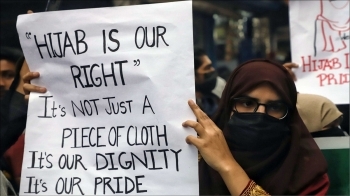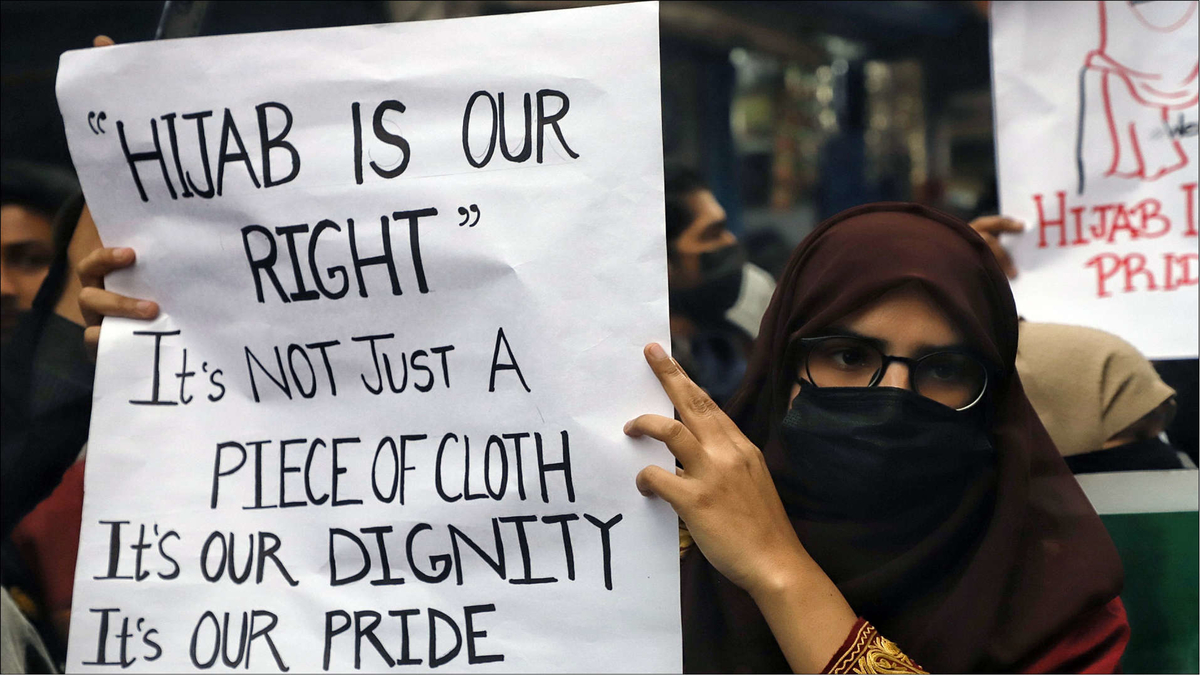
.jpg) Abdul Khaliq and Mathew John
Abdul Khaliq and Mathew John

When, as happened in France, an attempt is made to coerce women out of the burqa rather than creating a situation in which a woman can choose what she wishes to do, it’s not about liberating her but about unclothing her. It becomes an act of humiliation and cultural imperialism. -- Arundhati Roy
The hijab that a section of Muslim women and girls wear as religious insignia or as cultural identity or as an assertion of agency, whether ordained by dogma or not, is their personal concern and nobody else’s. But we have descended to such a new low in our sordid culture war that the hijab, which is expressive of a regard for modesty like the ghunghat, has now become the subject matter for arbitration by courts of law.
There is also a powerful subtext. What is personal attire to be decided by the wearer has become a contentious national debate for the simple reason that it is about Muslims, a community that has been under siege for the last few years. The hijab controversy is clearly a continuum in the “othering” of a community whose food, prayer service, love interests have already reaped death and life-threatening fratricidal hate.
In today’s cyber-explosive, social media-driven world of quickie knowledge, the erudite scholars who parade their wisdom in the rarefied stratosphere of academia, are lonesome voices that few care to hear. Fortunately for us, Bhanu Pratap Mehta, arguably the leading public intellectual and humanist of our time, has devoted a lifetime purveying his wisdom in the popular press, providing intense yet easy-to-read intellectual provender that we philistines are able to digest.
But to get to the point. In a recent piece titled ‘The Liberal Trap’ (IE, 23rd February), Mehta bemoaned “a new level of moral cretinism” in the public discourse on the hijab controversy. He identifies the brutal motivating force behind this allegedly progressive call for equal rights for women. Its raison de’tre, as he bluntly tells, is “to browbeat minorities and erase Muslim cultural presence in the public sphere.” He argues that the hijab, which is a small concession to religious belief like the turban or choti or the tilak and expressive of our rich diversity, does not in any way impede any civic purpose or compelling state interest.
As he rightly points out, the debate on the hijab as an instrument of patriarchy or oppression or anything else belongs to the realm of culture and not of law. He pulverises the sham of the so-called progressives, who are guilty of using the hijab controversy as a pretext to be comfortable with the BJP, and by association, actually condone state-sponsored cruelty.
Two individuals in this cabal of “progressives” need to be called out for their gloating public outbursts whenever the Muslim community is up against it. A prominent Muslim who grabbed the limelight with his principled stand in the Shah Bano case in the 1980s has since then become a choirboy of the majoritarian dispensation and been rewarded with the governorship of Kerala. At a time when there are orchestrated campaigns to erase anything Muslim from public spaces (namaz, abattoirs, halal meat), this know-all has waded into the hijab controversy with a litany of half-baked observations on Islamic dogma and practice, adding fuel to the fire of disinformation purveyed by the right-wing bullies about Muslims in general. What makes his intervention unconscionable is that he is not offering the Muslims counsel, on the contrary, actually emboldening the persecutors.
An even more vitriolic Muslim-basher is the convenor of the Indian Secular Muslims for Democracy (ISMD) who surfaces whenever the Muslims as a group are under attack. His prescription for Muslims to live peacefully in India is to roll with the punches.
His notion of “peace with honour”, expressed in 1992, even before the destruction of the Babri Masjid was for Muslims to appease the majority community by handing over the Babri Masjid site for construction of the Ram temple and thereby win “Hindu goodwill”, justice be damned. The honourable gentleman needs to be reminded that being a minority does not mean ceding your rights as an equal citizen. Expectedly, in the hijab debate, he has endorsed the Hindu right-wing’s sinister, motivated propaganda that the hijab is a symbol of oppression of women.
Despite having the most humane, egalitarian Constitution in the world, one cannot ignore the stark reality that in our society, all are equal but some are more equal, a pernicious affliction that has infected every walk of life but has been aggravated in the last few years.
All religious beliefs and communities are not treated alike and it is tragic that even our courts of law have been tainted by such an unconscionable bias.
To cite a glaring example, the Ayodhya judgement of 2019 ignored the fundamental precepts of law and definitively privileged the religion of the majority over the other creed. In the hijab case, the Karnataka High Court’s interim judgement is a violation of the fundamental rights of Muslim women students who wish to wear headscarves as part of their faith. The Supreme Court, which ingeniously shelved its own judgement in the Sabarimala case as it hurt orthodox Hindu sentiment, was unwilling to hear the petitions challenging the Karnataka HC interim order and bounced it back to the High Court, despite the seminal questions on fundamental rights involved.
What of the third estate – the common people of India? Social media -- every ordinary person’s amplified voice -- in the main has been critical of the hijab and its advocates. Significantly, the criticism is not restricted to the usual saffron-tinted right-wing suspects but has also drawn liberals to denounce the wearing of the hijab as an outdated construct of patriarchy and oppression of women. But they seem to miss the elementary point that the State cannot coerce women to discard the hijab.
The apologists for a hijab ban point to the example of France and the ruthless evisceration of the hijab from the public arena. Importantly, the burqa and veil which cover the face are banned in public spaces but not the headscarf. Recently though, French President Macron withdrew support for one of his party’s own candidates after she wore a headscarf in a campaign poster, indicating that “wearing ostentatious religious symbols on a campaign document is not compatible with the values” of the party.
One particular social media post which recently went viral is a 2009 report in The Guardian newspaper with the heading “Nicolas Sarkozy says Islamic veils are not welcome in France”. It was clearly intended to whip up support for the Karnataka High Court’s interim order banning the hijab in schools on the grounds that the judgement was in keeping with what the Western civilized world regards as an imperative in a secular Republic. But then, to modify what Alexander Pope said, knowledge that is partial can be a dangerous thing.
What’s happening in our benighted country is actually a complete negation of the ‘hard’ secularism practised in France or for that matter, the more indulgent multi-culturalism of some other Western democracies.
The French version of secularism as defined by laicite expels religion beyond the precincts of State law and is an emphatic repudiation of any kind of religious control in matters of the State. Until the late 18th century, Roman Catholicism, which was in cahoots with the Ancien Regime, was the state religion of France, but the French Revolution upended that cosy relationship among the privileged. The newly created French Republic announced its secular intent by confronting the Catholic Church and Catholicism and asserting its control over the public square.
In this model of secularization, individual cultural backgrounds were expunged and relegated to the private sphere. But importantly, while laicite frees the public space from religious control, the French State does not interfere with religious dogma except where it affects public order. For instance, in France, a woman cannot sue the Church for not being allowed to become a priest, although it is a blatant example of gender discrimination.
In contrast, other Western nations like the US, the UK and Canada practise a secularism that does not deny the presence of religion in the public square but ensures that it seeks no special privileges and remains subservient to the law.
This is not what is happening here. Secularism’s underpinning philosophy, which calls on civic society to free itself from religion without necessarily denying it, to extend no special privileges to any religion and to ensure that all religions are treated equally, but that sacred responsibility has been cruelly betrayed in our benighted land. Today, the dividing line between religion and the State is non-existent but what’s worse, there is an unmistakable religious hierarchy, the religion of the majority enjoying privileged star status, whereas other religions are tolerated, and Islam barely so.
The hijab controversy will hopefully die down but time will not heal the damage it has done to our social ethos. The most tragic outcome of this latest episode in our communal cauldron is that the very young, sporting hijabs and saffron scarves, have been inducted into this macabre dance of hate, even as the lead choreographer watches silently.
(Abdul Khaliq and Mathew John are former civil servants. Khaliq is also the secretary general of Lok Janshakti Party (Ram Vilas). Views are personal)